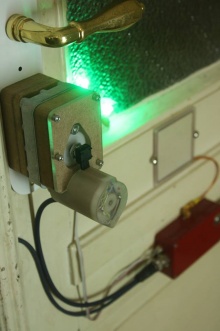YNNOK: Unterschied zwischen den Versionen
Bilex (Diskussion | Beiträge) Keine Bearbeitungszusammenfassung |
Bilex (Diskussion | Beiträge) Keine Bearbeitungszusammenfassung |
||
| Zeile 36: | Zeile 36: | ||
==Electronics== | ==Electronics== | ||
YNNOK works with a Atmega8 mikrocontroller programmed with avr-gcc. Next to that is a MAX485 to get data from outside into the device and a L293D motordriver IC to get the motor running. Since YNNOK works all day and night it is important to focus on efficiency. Instead of using a 7805 | |||
<gallery> | <gallery> | ||
Version vom 12. April 2014, 23:31 Uhr
| YNNOK Release status: stable [box doku] | |
|---|---|

| |
| Description | NFC Door opening mechanism. |
| Author(s) | A.B. (Bilex) |
| Platform | Sophistication |
Information
YNNOK (You Need NO Key) is an AVR driven RFID door opening device. A small motor is directly attached to the lock and turns a shortened key like a human would do to lock or unlock the door. A 125khz RFID system detects transponders, reads the inner ASCII string and compares it to a list of valid strings. YNNOK is connected to a RS-484 databus to communicate with the local WiFi router. This makes the system accessible with your computer or any handheld device. Since this ability the NFC option is hardly used but still implemented.
Mechanics
The mechanical heart of YNNOK is a low-budget DC gearmotor. It operates with 12V and is connected to a L293D motordriver IC. A small brass adapter with a 2mm groove grabs the key and turns it around. In order to give the AVR information about the position of the key a potentiometer was installed a the backside of the motor. A gear reduction between the motor and the poti shaft increases the operation range of the poti. Due to this trick a common poti can measure more than two total rotations which is important to lock the door twice. The accuracy of this simple feedback system is still satisfying enough to turn the key into three positions by reading the poti with a 10-Bit ADC.
The lock inside the door is old and creepy. Under normal conditions it works fine, but sometimes it stucks. Especially if a user tries to lock the door and pulls it at the same time. To prevent a mechanical damage, the motor current is measured. If the motorcurrent grows above a certain level the motor will turn to its normal position again.
After a few weeks of operation the open backside of the motor with touchable cables and solder contacts annoyed a few frequent YNNOK users. To make it more safe and to have a proper cable guidance a motorcap was printed with a 3D printer.
YNNOK was designed with Autodesk Inventor and most parts were manufactured with the DAS-LABOR CNC-Fräse.
Electronics
YNNOK works with a Atmega8 mikrocontroller programmed with avr-gcc. Next to that is a MAX485 to get data from outside into the device and a L293D motordriver IC to get the motor running. Since YNNOK works all day and night it is important to focus on efficiency. Instead of using a 7805
Video
To be done..



